King Features (1960-1961), Koch Vision (April 27, 2004), 3 discs, 480 mins, 1.33:1 original full frame ratio, Dolby Digital 2.0 Mono, Not Rated, Retail: $29.98
Storyboard:
Popeye The Sailor looks his most un-Popeye-ish in this collection of television cartoons from a variety of production houses.

The Sweatbox Review:
Okay, so I’m a sucker. Go ahead and say it. I was warned against picking up this three-disc set of television Popeye cartoons, and was told that they were among the worst things ever done with the sailor. But I love Popeye. And I am always interested in how my favorite characters have been translated into various media. And that box just looked so darn purty… So here we are. Many have bad-mouthed this set purely on the basis of hearsay. But how many were brave enough to actually purchase it? Well, kids, I took one for the team here, by buying this set for myself. I watched it so you could read my review and decide for yourselves if this is a box you want on your shelf.
This set was one of several Popeye compilations brought out in 2004 to celebrate the character’s 75th anniversary. At this time, cartoon collectors had become accustomed to asking for the 1930s Fleischer studio shorts, and had to become used to settling for the same old set of public domain Fleischers or Famous Studio cartoons. This set is different, though. It collects 85 cartoons that were produced for television in 1960-61. These cartoons came about in the wake of enormous popularity for the older theatrical shorts when they were shown on television. Famous Studios (the former Fleischer studio owned by Paramount) was no longer making Popeye cartoons, so the character’s owner, King Features Syndicate, decided to commission new cartoons from a few different smaller studios. These shorts appeared on a new syndicated Popeye program.
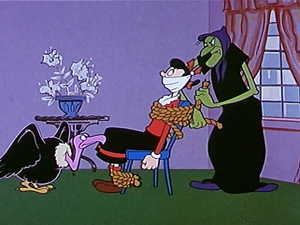
A total of 220 cartoons were produced in this small period of time, all utilizing limited animation and very low budgets. The results were predictably uneven, and often not very good at all. The best of them are usually the ones done by Paramount, who ended up being a big contractor for the show. Seymour Kneitel, a Popeye veteran since the Fleischer days, directed many (or all?) of the Paramount-produced KFS Popeyes. These ones tend to have some of the slickest animation, given the budget restraints. The stories from the Kneitel team also tend to be better presented than some of the other efforts. The greatest number of cartoons were produced by a team led by Jack Kinney, who had previously worked on many Disney features and shorts, as well as UPA’s 1001 Arabian Nights (starring Mister Magoo’s ancestor). Despite Kinney’s impressive credentials, his Popeye efforts undoubtedly come under the category of his lesser works. Gene Deitch was another contracted director for the KFS Popeye cartoons. He is infamously known for doing a number of substandard “Tom and Jerry” cartoons for MGM using an eastern European studio. Perhaps the best thing that can be said of his Popeye cartoons is that they are not as disliked as his Tom and Jerry ones. Lastly and probably least in this group of directors is Larry Harmon, producer of the Bozo live action and cartoon shows.
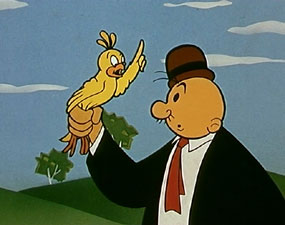
However, for many people these cartoons remain “their” Popeye, the one they grew up with. It is doubtful that anyone would argue against the superiority of the Fleischer Popeyes, but for many the KFS cartoons still hold a nostalgic appeal. Well, I had never seen these cartoons before, so my only nostalgia was for the characters themselves. For me, that is the main appeal with these cartoons, since they use a larger part of the newspaper strip’s cast than previous animated versions. Not only do we get Brutus, Olive, and Wimpy, the KFS cartoons also regularly feature the villainous Sea Hag (looking green, with Bernard the vulture) and baby Swee’pea, as well as appearances by King Blozo, Alice The Goon, a speaking Whiffle Hen, and Eugene The Jeep.
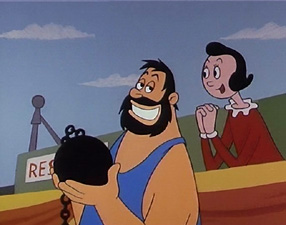
And I did say “Brutus”. Popeye’s nemesis was known as Bluto when he first appeared in the Thimble Theater comic strip (although he was initially planned as a one-story character) and the Fleischers developed him into an ongoing foe for Popeye. For some reason, someone at King Features thought that KFS would not hold the rights to use Bluto in the TV cartoons, apparently thinking that he was a creation of the Fleischers. Thus, an essentially identical character named Brutus was born. He was even still voiced by Jackson Beck, who had done Bluto in the Fleischer and Famous shorts. Later on, KFS realized their error and had an episode where it was shown that Bluto and Brutus were brothers. Meanwhile, the newspaper strip and comic books (mostly done by Bud Sagendorf at the time) switched to using the name Brutus, since that was how the television audience knew him. Since then, the character has been known by either name in various media. Me, I still prefer “Bluto”.
Beck was not the only voice to follow Popeye to television. Jack Mercer was still Popeye, just as he still would be for Hanna-Barbera years later. He ended up doing Popeye for an amazing 45 years! Also, the Fleischer/Famous Olive Oyl, Mae Questel, returned to perform Olive, as well as the Sea Hag and Eugene.
So, the voice work was in good hands. The visuals on the other hand… Yikes! I can accept the white sailor outfit, which Famous had first given Popeye years earlier, but why does Popeye have two big eyes in these cartoons? Sometimes he is shown squinting with one eye or the other, but everyone knows that he only has one eye!! Olive is also given big eyes, replacing the black dots with which she is normally drawn. I also gaped to see Olive demonstrating a curvy figure in some of the cartoons (especially Deitch’s Sea No Evil, undoubtedly the homeliest of all the cartoons in this collection— check out the screen capture below).
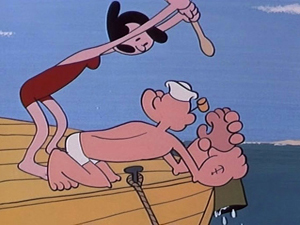
These cartoons show a step down in drawing quality from the Famous cartoons all around. Even the better Paramount Cartoon Studio efforts directed by Seymour Kneitel, generally the most watchable of the KFS shorts, look cheap. The Deitch ones tend to have the weakest drawing of them all, looking even amateurish at times, something like the first season of Rocky And Bullwinkle but without decent scripts. Incidentally, Kinney’s Barbecue For Two, being a pilot for the cartoon series, has a different style altogether. It has Popeye in the traditional blue sailor suit, and the character designs are closer to the comic strip. In this one, Olive has her black-dot eyes, but Popeye still can’t decide which eye to squint.
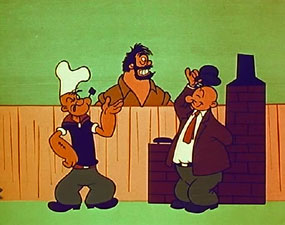
The stories run from such very pedestrian set-ups as a car wash or picnic, to more interesting ones that more closely reflect Popeye’s comic strip origins like meeting Eugene The Jeep for the first time (Jeep Is Jeep) or Popeye finding his dad (Me Quest For Poopdeck Pappy). The basic plot does not necessarily make or break a cartoon, however, as even a lame plot can produce an involving cartoon, while bad animation can sabotage even the best story. It does not help that these cartoons are less than six minutes long, including credits (shown in their entirety on the discs, including title cards), making them even briefer than a typical theatrical short. Add to that the occasional use of meaningless set-up sequences that involve Popeye telling a story to Swee’pea (Golden-Type Fleece, Popeye Revere, or Little Olive Riding Hood) or Olive’s nice Deezil (The Mark Of Zero). In those cases, you are only left with about four minutes to tell a story, which makes for either a rushed or empty narrative.
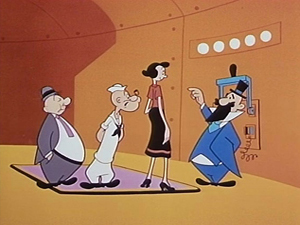
Just watching the first two cartoons in this set is a perfect example of what one should expect. The first cartoon, Hits And Missiles, is by Seymour Kneitel, and wound up being one of my favorites. It concerns Popeye, Olive, and Wimpy taking an accidental trip to the moon on a rocket ship. Once on the cheese-terrain moon, they are captured by cheese soldiers and must battle a despotic cheese king. It’s loopy and fun, despite the limited animation. Next up, though, is Plumber Pipe Dream from Jack Kinney, a total mess of a cartoon. Here, we have a mundane plumbing plot, the lip-synching is poor, the gags and animation are uninspired, and there is an awkward fadeout to the end titles that cuts off the last line of dialog. In its defense, the cartoon does turn to Tex Avery-like outlandishness, but the ending (unforgivably given away by the title) is lame. From here on, it is a crapshoot as to what each cartoon will bring.
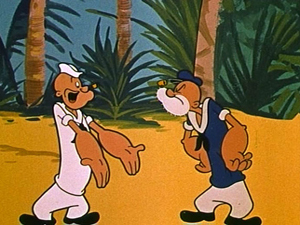
As I mentioned, even though the Kneitel cartoons are certainly not uniformly great, the better cartoons in this set are usually his. Popeye’s Double Trouble sees the Sea Hag taking Olive’s place during a dance competition, and Incident At Missile City has Popeye responding to a plea for help from King Blozo. The Poopdeck Pappy one is his, too. Watching that one, I was struck by how much Pappy sounded like Ray Walston’s portrayal in the 1980 film. My complaint with Me Quest For Poopdeck Pappy, though, is that there are no Goons, even though Pappy is on “Goona Island” (in contrast to the Goon-filled Fleischer cartoon with a similar storyline, Goonland). Not to worry, though. There are a few Goons on Goon Island in Kinney’s Old Salt Tale.
I found the quality of the Kinney cartoons to be particularly tough to predict. While the odd one is decent (well, at best mediocre), some of them border on nonsensical. Especially bad are the time travel ones with Professor O.G. Wataschnozzle, such as Out Of This World or Invisible Popeye, which are quite hard to follow— like a one-hour show that had been condensed into five minutes, with poorly-executed layouts and weak drawing besides. The Harman cartoons, though they get a bad rap, do include a few worthwhile nuggets. Mueller’s Mad Monster, for example, has some nice special effects and a Chuck Jones-like mad scientist vibe going for it.
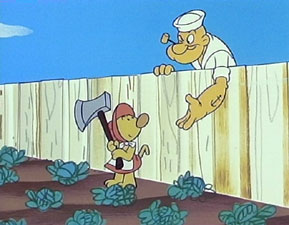
And poor Gene Deitch had the ugliest cartoons, even though the stories had potential. Insultin’ The Sultan, for example is just plain badly drawn, but has a good premise: Popeye has joined the Foreign Legion after a fight with Olive. Meanwhile, the Sultan in the kingdom where Popeye is stationed decides to make Olive his 75th bride. Well, it is all pretty contrived, I suppose, but no more so than many more classic cartoons.
This set has three discs, containing 29 + 36 + 20 cartoons, for a grand total of 85. If you have the time to wade through the bad ones, you are bound to find at least a couple you kind-of like. Detractors will point out that these are far behind the Fleischer Popeye cartoons in quality, but they are what they are: vintage early television cartoons done for little money, in a small amount of time, by artists of varying talent, that happen to have an alternate version of our favorite spinach-eating sailor.
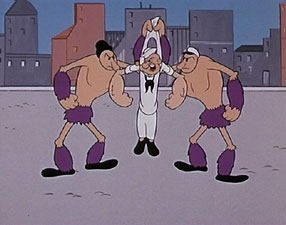
Is This Thing Loaded?
There is a link to Koch Vision Online, accessible from your DVD-ROM drive. There are no Popeye bonuses on the discs.

Case Study:
I have to hand it to Koch in this department. They at least put out a nice looking package. The three discs come in a glossy foldout digipack that is housed in a similarly glossy cardboard slipcase. All the artwork reflects the KFS cartoon designs, and we should give Koch credit for properly describing the contents on the back cover, even if some fans may be temporarily confused by the “75th Anniversary” labeling.
Ink And Paint:
On the plus side, these are surprisingly clean, bright prints that naturally have some blemishes but on the whole are very pleasing to watch. The minus side is that the transfers have been given an over-processed look, with shimmering and heavy edge enhancement resulting in broad halos (some cartoons looking worse than others). The overall effect is far from film-like, but on smaller sets the problems will be minimized and you will still be able to appreciate the sharp colors. A few of the cartoons have a grainy appearance, but those ones actually seem truer to the source material in some ways.

Many of the other problems one could mention have more to do with the original source material. Like many productions of that era, there is a significant amount of cel dust, and quality control on the KFS cartoons was not great. While watching a cartoon like Jeep Is Jeep, one may wonder why Popeye is orange when everyone else has normal flesh tones, but that cannot be blamed on the DVD.
Scratch Tracks:
The 2-channel mono soundtrack is decent. There is a bit of a tinny quality to it at times, but it is at least as good as what one could expect. The dialog is always clear (Jack Mercer did not mumble on these tracks like he did on the Fleischer cartoons, which was charming but often made Popeye hard to understand in those older shorts). Really, I have no complaints about the audio, but remember it’s just a cheap Sixties cartoon.
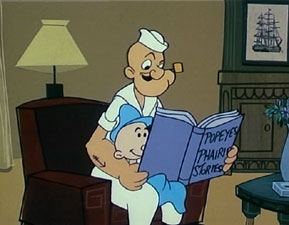
Final Cut:
If you realize what you are in for, this collection can be a passable time waster. I found this set’s worth mostly in being able to experience what it was like on the animation scene in the early days of television. The appearance of many of Popeye’s supporting cast adds interest to this collection, but the poor animation prevents these cartoons from being much more than a historical curiosity. They are perfect, though, if you have had a long day, your small child/niece/nephew wants to watch cartoons with you, and you want something where you will not mind interruptions for potty breaks or snacks. Those who grew up with these cartoons will no doubt benefit from the nostalgia factor as well. And it’s 85 cartoons for about twenty bucks! It is certainly a case of volume over quality, but Popeye diehards may well still be tempted.
 | ||
 |







